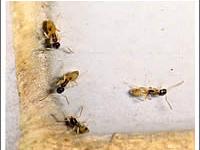Confused Flour Beetle (Also see Rust-Red Flour Beetle)
Granary Weevil (Also see Rice Weevil)
Mediterranean Flour Moth or Mill Moth
Red-legged Ham or Copra Beetle
Rice Weevil (Also see Granary Weevil)
Rust-Red Flour Beetle (Also see Confused Flour Beetle)
Tropical Warehouse or Almond Moth (Also see Warehouse, Tobacco or Cocoa Moth)
Warehouse, Tobacco or Cocoa Moth (Also see Tropical Warehouse or Almond Moth)

Appearance
Tiny, 1.5-2mm long, with black to dark brown head and mesonotum and a distinct pale yellowish-white gaster; node absent on petiole.
Notes
One of the most common ants found in urban dwellings and readily enters buildings, inhabiting crevices, cracks in walls and between cabinets and walls, soil of potted plants, old bandages, cloth lining of instrument cases and even laptops. Workers are monomorphic and run rapidly and erratically, forming trails along edges and corners. Trails are often hidden under carpets and along electrical wires. It has high moisture needs and often trails to wash-basins, commodes and bathing areas. In an outdoor environment, the ant prefers honeydew and insects, both dead and living; indoors, it can be seen running about on dining tables and kitchen slabs, looking for sweet food and sources of water.
Colony : moderate to large, can contain thousands of workers and many queens.

